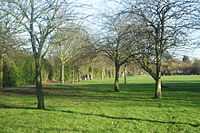Beckenham Place Park
| Beckenham Place Park | |
|---|---|
|
Beckenham Place Park is the largest green space in Lewisham | |
| Type | public park |
| Location | London, England |
| Coordinates | 51°24′54″N 0°01′13″W / 51.415137°N 0.020143°WCoordinates: 51°24′54″N 0°01′13″W / 51.415137°N 0.020143°W |
| Area | 96 hectares (237 acres) |
| Created | 1927 (golf course 1929) |
| Operated by | London Borough of Lewisham |
| Status | Open year round |
| Website |
lewisham |

Beckenham Place Park is a large park located in the London Borough of Lewisham. It lies close to the border with London Borough of Bromley. It includes an 18-hole public (municipal) golf course. The Palladian-style former mansion that gave the park its name now serves as an information centre and golf course clubhouse and cafe.
History of the park
Beckenham Manor has medieval origins and is mentioned in the Domesday Book as belonging to the Bishop of Bayeux. In the 17th century, the whole estate was owned by Walter St John, with manorial rights passing to the noted Quaker and MP John Cator in 1773.[1]
Cator, reputed to be friends with Swedish botanist Carl Linnaeus and son-in-law of Peter Collinson, introduced many exotic tree species and a lake, which is now dry. Even today, there are reputed to be 60 species of tree on the estate. Cator built the mansion that stands today.[1] The evidence for a visit by Linnaeus is slim, he is only recorded as visiting England in 1735, long before Cator's birth and time at Beckenham Place. Although Linnaeus corresponded with Peter Collinson or Collinson wrote to Linnaeus regularly about botonay etc. there is no firm evidence (perhaps yet to be found) that Linnaeus or indeed, Collinson, had direct input into the landscape design of Beckenham Place Park. However, Collinson's daughter Mary, John Cator's wife, would presumably have been influenced by her fathers experience with his gardens at Peckham and Mill Hill as well as his interest in collecting and introducing plants to Britain. Collinson's letters recorded in 'Forget Thee Not My Garden' are interesting and insightful. Investigation of the life spans of Linnaeus, Collinson and Cator and the acquisition of Beckenham Place at least suggest that the meeting and involvement was unlikely if not impossible.
The mansion remained with the Cator family until the 20th century, although inhabited by tenants for most of the 19th century – including a boys school and sanitorium in the early 20th century – before being bought by London County Council in 1927. When the golf course (established in 1907) became in 1929 the first municipally owned course in England (and also reputedly the busiest). The mansion was retained as a clubhouse. During World War II, the park became a prisoner of war camp and defensive measures including anti-aircraft battery and barrage balloons were installed.[1]
The park was later managed by the Greater London Council, then by Lewisham borough council from 1972. In 1995 after boundary changes the park is entirely within the Borough of Lewisham – formerly falling within two boroughs according to boundary markers which can still be seen in Summerhouse Hill Wood.[1]
Layout and notable features
Beckenham Place Park is Lewisham's largest green space, extending to 96 hectares (237 acres), and including a wide range of facilities, including ball court, football pitches, tennis court and sensory garden. The par 69 pay-as-you-play course offers golf tuition from a PGA golf pro and also clubhouse facilities in the Grade II* listed mansion.[2]
A railway bisects the park and the only routes joining both parts are the bridge north of woodland called the Ash Plantation or by leaving and re-entering the park in the vicinity of Ravensbourne railway station. Hence, the railway effectively divides the park into west and east sides.
Beckenham Place Park is considered one of the finest wildlife sites in the borough, containing ancient woodland as well as a variety of other habitats.[2] Notable trees include oak, wild service tree, sweet chestnut and an ancient Turkey oak tree (reputedly the second oldest in Britain), that survived an arson attack in the 1990s. There is also an old mulberry tree near the 18th hole of the golf course.[1]
It is a Local Nature Reserve[3] and a Site of Metropolitan Importance for Nature Conservation[4] It is also part of the Green Chain Walk and Capital Ring.
See also
| Wikimedia Commons has media related to Beckenham Place Park. |
References
- ↑ 1.0 1.1 1.2 1.3 1.4 "London Gardens Online". London Gardens Online. Retrieved 2013-07-17.
- ↑ 2.0 2.1 "Lewisham Council - Beckenham Place Park". Lewisham.gov.uk. Retrieved 2013-07-17.
- ↑ "Beckenham Place Park". Local Nature Reserves. Natural England. 1 March 2013. Retrieved 22 January 2014.
- ↑ "Beckenham Place Park". Greenspace Information for Greater London. 2013. Retrieved 22 January 2014.
External links
- "Map of Beckenham Place Park". Local Nature Reserves. Natural England.
- Friends of Beckenham Place Park
- Beckenham Place golf home page
- Green Chain description of Beckenham Place Park
| ||||||||||||||||||||||||||||||||||||||||||||||||||||||||||||||||||||||||||||||||||||||||||||||||||||||||||||||||||||||||||
